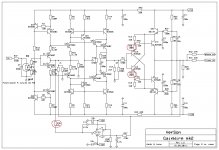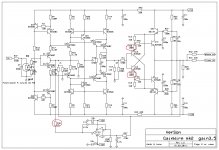hum practically disappears (listening in the silence of night) when I move the transformer about 12-16cm 🙂D) from the board.
When listening tests with preamp are finished, I'll start (I hope so...) populating one amp PCB. In the same time, I'll design the preamp box. What is the exact distance between preamp mounting holes ?
There six mounting holes on the PCB. It is easy to measure the distances from that. Use 10 to 15 mm distance to bolt the PCB to the box bottom.
I'd like to measure center-to-center holes very accurately so I can send all the data to Schaffner to make a beautiful box... I hope there is no 0.5mm mesurements in original design.
I measure 119mm width, 100mm and 94mm long. Can you please confirm this ? 😉
I measure 119mm width, 100mm and 94mm long. Can you please confirm this ? 😉
I'd like to measure center-to-center holes very accurately so I can send all the data to Schaffner to make a beautiful box... I hope there is no 0.5mm mesurements in original design.
I measure 119mm width, 100mm and 94mm long. Can you please confirm this ? 😉
Sorry for late answer, weekend reserved for my grandsons.
Sorry for not clear distances between the mounting holes, I did not think it's important.
The best way you do the drilling when the box arrived. My measurement from the Sprint layout is different then you posted, and I do not have any spare PCB to make the measurement, my prototype preamp was built on a bit different PCB.
The sprint layout shows: 122.5 mm with, 99.5 mm and 94.7 mm long, so better make a drills by placing the board and mark the drilling points.
Damir
Listening with Spendor 2/3E loudspeakers and JLH 80W mosfet amplifier :
Sound is very accurate and detailed. High transparency allows to hear this, I mean everything, with no fog or clouds in the sky. Clarity in the highs is excellent. Response is fast, with no trail. Instruments are very well separated, with air between them. The sounstage is very balanced.You can hear all the mystery of music through intentions made by musicians.
In my opinion, GNFB is easier, softer than CFA mode. With CFA mode, source should be more carefully choosen. Straight and tight source must be avoided. In both modes, defects of sources or loudpeakers are highlighted.
I love this preamp. Thanks, Dado, for designing it! 🙂
Sound is very accurate and detailed. High transparency allows to hear this, I mean everything, with no fog or clouds in the sky. Clarity in the highs is excellent. Response is fast, with no trail. Instruments are very well separated, with air between them. The sounstage is very balanced.You can hear all the mystery of music through intentions made by musicians.
In my opinion, GNFB is easier, softer than CFA mode. With CFA mode, source should be more carefully choosen. Straight and tight source must be avoided. In both modes, defects of sources or loudpeakers are highlighted.
I love this preamp. Thanks, Dado, for designing it! 🙂
Listening with Spendor 2/3E loudspeakers and JLH 80W mosfet amplifier :
Sound is very accurate and detailed. High transparency allows to hear this, I mean everything, with no fog or clouds in the sky. Clarity in the highs is excellent. Response is fast, with no trail. Instruments are very well separated, with air between them. The sounstage is very balanced.You can hear all the mystery of music through intentions made by musicians.
In my opinion, GNFB is easier, softer than CFA mode. With CFA mode, source should be more carefully choosen. Straight and tight source must be avoided. In both modes, defects of sources or loudpeakers are highlighted.
I love this preamp. Thanks, Dado, for designing it! 🙂
Thank you Nicola for detailed listening opinion.
Dado
Quite time passed sins the boards where delivered and no to much comments about the building results.
I appreciate if some of you who finished the preamp describe listening impression, or if some problems occurred during assembling.
thanks, Damir
I appreciate if some of you who finished the preamp describe listening impression, or if some problems occurred during assembling.
thanks, Damir
Will now start to populate your boards.... subjective comments soon 🙂
Thanks RC.
During my listening sessions and extensive testing I decided to change few resistors.
R30 and R31 from 270R to 180R, no need for 40 mA output bias, new is set to 30 mA and less heat of Q23 and Q24.
R36 from 22k to 12k, simpler work for the DC servo's OPA.
Here are two schematic, first one with gain set to 7 and second one with gain set to 3.5.
Damir
R30 and R31 from 270R to 180R, no need for 40 mA output bias, new is set to 30 mA and less heat of Q23 and Q24.
R36 from 22k to 12k, simpler work for the DC servo's OPA.
Here are two schematic, first one with gain set to 7 and second one with gain set to 3.5.
Damir
Attachments
Congrats, dadod.
Well, this clever design should benefit, i imagine, from two mods.
First a SMD design, and second, to be battery powered.
Not that i fear noise from the shunt regulator, but to remove any parasitic current through ground wiring (AC pollution across PS transfo).
Easy to test with 9V batteries, to figure out, but i'm sure it will make a huge difference.
Well, this clever design should benefit, i imagine, from two mods.
First a SMD design, and second, to be battery powered.
Not that i fear noise from the shunt regulator, but to remove any parasitic current through ground wiring (AC pollution across PS transfo).
Easy to test with 9V batteries, to figure out, but i'm sure it will make a huge difference.
Last edited:
Congrats, dadod.
Well, this clever design should benefit, i imagine, from two mods.
First a SMD design, and second, to be battery powered.
Not that i fear noise from the shunt regulator, but to remove any parasitic current through ground wiring (AC pollution across PS transfo).
Easy to test with 9V batteries, to figure out, but i'm sure it will make a huge difference.
Thank you Esperado,
I am a bit afraid of a SMD, to small for DIY soldering(I am to old for that) and then I have to learn how to make good layout with the SMD, but I will try it just need time(winter is coming, best time to do such things).
Regarding battery powered, I am not sure, there is simpler way with ICs and OPAs (TI has very good CFA OPA designed for a headphones).
BR Damir
I was not thinking specially about headphones, suggesting batteries, but preamplifier and voltage injected to the ground across the capacitance of the transfo's coils.
Just try-it, you will be surprised.
About CFA OPAs, that's what i use in my pre-amp. OP260 from AD. And it is battery powered. I had made a little circuit witch detect the signal on the output, and disconnect all AC wires. It is charging (Delta peak) the rest of the time.
Just try-it, you will be surprised.
About CFA OPAs, that's what i use in my pre-amp. OP260 from AD. And it is battery powered. I had made a little circuit witch detect the signal on the output, and disconnect all AC wires. It is charging (Delta peak) the rest of the time.
Listening with Spendor 2/3E loudspeakers and JLH 80W mosfet amplifier :
Sound is very accurate and detailed. High transparency allows to hear this, I mean everything, with no fog or clouds in the sky. Clarity in the highs is excellent. Response is fast, with no trail. Instruments are very well separated, with air between them. The sounstage is very balanced.You can hear all the mystery of music through intentions made by musicians.
In my opinion, GNFB is easier, softer than CFA mode. With CFA mode, source should be more carefully choosen. Straight and tight source must be avoided. In both modes, defects of sources or loudpeakers are highlighted.
I love this preamp. Thanks, Dado, for designing it! 🙂
I `ve constructed similar Input stage for my power amp but with jfets input and you`re right about CFA mode I got the same listening expirience, and I think you should try to try bigger value C2 when in cfb mode.
Anyway, line stage in my opinion don`t need GNFB at all particularly with this design, you have very low distortion without GNFB...
I `ve constructed similar Input stage for my power amp but with jfets input and you`re right about CFA mode I got the same listening expirience, and I think you should try to try bigger value C2 when in cfb mode.
Anyway, line stage in my opinion don`t need GNFB at all particularly with this design, you have very low distortion without GNFB...
Yes you are correct, C2 is 220 pF for the version with the gain of 3.5, I forgot to change it on the schematic.
OMHO, the benefit of CFA is not about distortion (anyway low under audibility threshold).you`re right about CFA mode I got the same listening expirience...
Anyway, line stage in my opinion don`t need GNFB at all particularly with this design, you have very low distortion without GNFB...
It is the expansive behavior (Current on demand) witch enlighten transients.
I believe this is the reason of the concordant listening reports about CFA: more presence and details, fluid trebles and even this feeling of more light and aerial basses (more attack, less sustain).
I'm very happy to see more and more people here are trying CFAs and understand, now, the benefit of this topology by their own listening experience.
i wonder where are the measurements promised by Richard. I had a quick look to the thread, but cannot found them.
i wonder where are the measurements promised by Richard. I had a quick look to the thread, but cannot found them.
I think Richard never assembled the preamp.
Sorry, I did not assembled it...... too time consuming. I hoped it would have been populated with parts so i could just run the tests and measurments. BTW - just returned from 2 months in Asia. If you have one built, I'll test it.
-Richard Marsh
-Richard Marsh
Last edited:
Ah, ok. Too bad, a good opportunity to compare sim results to reality on two different topologies at once.I think Richard never assembled the preamp.
- Status
- Not open for further replies.
- Home
- Amplifiers
- Solid State
- No NFB line amp (GainWire mk2)

